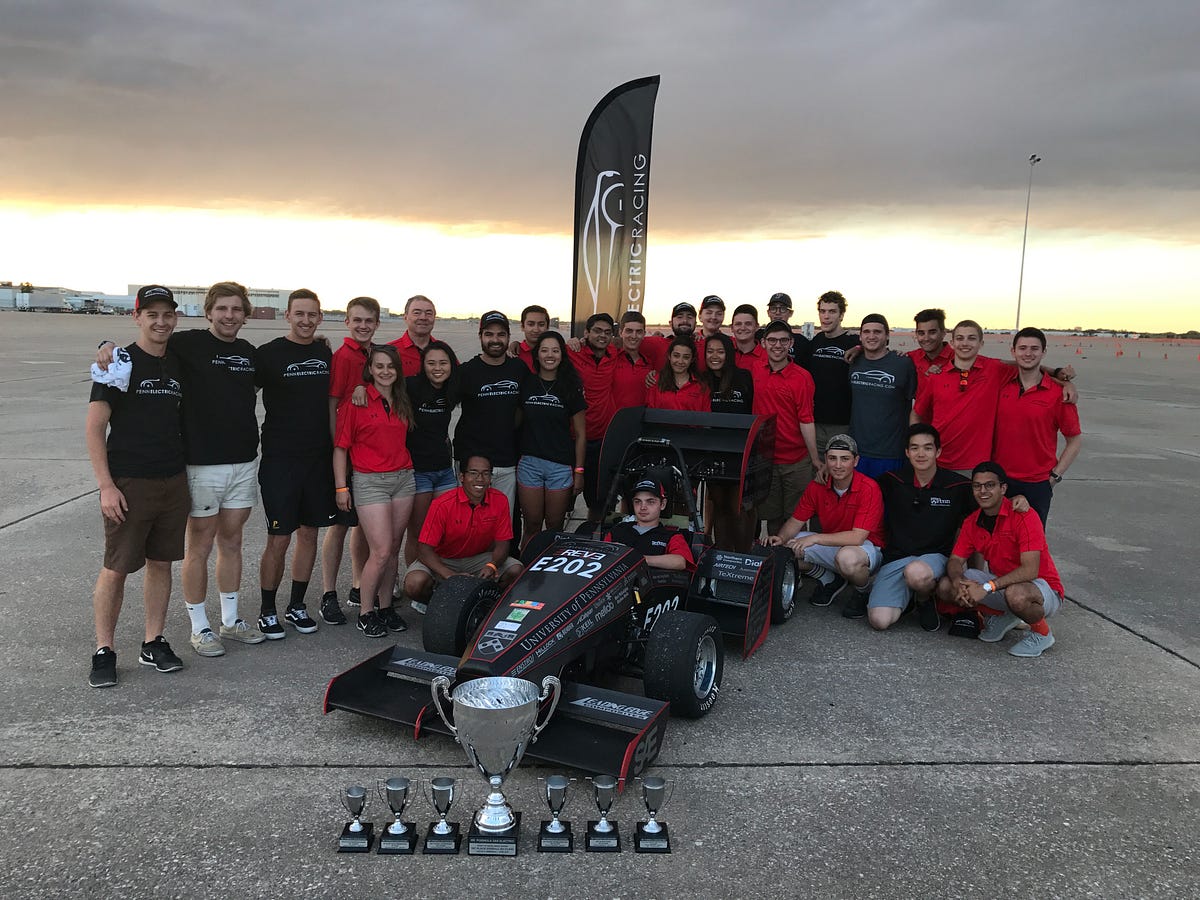Penn Electric Racing team leads the pack in North America

The Engineering-based Penn Electric Racing team is on a roll. After their early-June win in the Electric Vehicle division at student racing competition Formula North 2017 in Barrie, Ontario, they took home the electric gold at Formula SAE 2017 in Lincoln, Nebraska last week. The event is the premier student racecar design competition in North America.
The all-undergrad team draws on expertise from throughout the school, including the Departments of Mechanical Engineering and Applied Mechanics, Electrical and Systems Engineering, and Computer and Information Science. Penn Electric Racing (PER) leadership consists of captain Dan Shanks, co-managers Sina Golkari and Connor Sendel, electrical team co-leads Jay Fleischer and Johnathan Chen, and mechanical team co-leads Liam Cook and Matt Mendivil. With business and budget considerations a factor in the competition, the team also relies on the skillsets of several members of the Jerome Fisher Program in Management & Technology, including Golkari, Sendel and Chen.
The Electric Vehicle (EV) division at Formula SAE has grown impressively since its inception in 2013. This is the first year the number of cars registered reached the limit of 30 set by SAE, the International Society of Automotive Engineers. However, many electric teams find the challenge of developing a competitive car to be daunting and natural attrition from teams not able to finish in time resulted in a final lineup of 22 electric teams in Lincoln.
This year, 11 of these EV teams satisfied the electrical, mechanical and safety requirements necessary to participate in track-based events, up from five in 2016 and two in 2015, showing growing competition in the electric division.
“Having nine electric cars competing in the 15-mile endurance track made it very exciting to watch. I think there were only three functional cars running last year,” says aerodynamics lead Alex Shea. “For each event, we can set the rear wing to a different angle of attack.”

The EV competition comprises five dynamic events, including acceleration, autocross, endurance, skid pad (which measures cornering ability) and fuel efficiency, and three static presentation events in the areas of business, cost and design. Penn came in first in acceleration, autocross and endurance, as well as in the cost and business presentations. The team came in second in skid pad and efficiency among the cars that completed in endurance, and third in design.
Overall, Penn Electric Racing placed first with a total of 923 points out of a possible 1,000; MIT came second with 858 points; and Universidade Estadual de Campinas of Brazil, which won the EV competition in 2013 and 2014, were third with 667 points.
Race cars powered by internal combustion engines compete at the same event and make up the majority of the field; the SAE limit of 80 registered IC cars is always met.
“PER has done consistently well among the electric teams, and we’re now becoming increasingly interested in how our car stacks up against the gas ones,” says battery designer Andrew Remec.
“And since we’re battery-powered, we can apply instant max torque to the wheels, something no IC team can come close to replicating,” says powertrain lead Spencer Collins.

In the acceleration event, a 75-meter standing-start drag race, Matt Mendivil’s time of 4.095 seconds was the fastest of all 54 cars, internal combustion and electric, that qualified for the event. This was equivalent to an acceleration of 0–60 mph in 2.6 seconds with a speed of more than 85 mph at the end of the run.
In the one-mile autocross, with Dan Shanks and Liam Cook driving, Penn ranked 13th of the 68 cars competing. In the 15-mile, 17-lap endurance race, driven by Mendivil and Cook, Penn had the 12th fastest lap time of the 36 competitors.
“If PER were competing in the mature, three-decades-old internal combustion division, the team would place 12th out of 80. Not bad for a four-year-old EV team. Aiming for number one overall is a great target for the future,” Shanks says. “As we strive to continue our success, we face challenges like knowledge transfer and managing such a large team. It’s hard to balance teaching how the car works with actually designing it.”
The Penn Electric Racing team has grown dramatically over the four years of its existence. The first team had nine members; this year, 50 team members were active in the development of the car and 31 traveled to either Barrie, Lincoln or both. Beyond the excitement of the competitions, PER team members get hands-on experience in a variety of skills, such as vehicle dynamics, battery design, electric motors, motor controller design and coding, telemetry, sensors, transmissions, suspension and aerodynamics as well as management, operations and fundraising.
“It’s surreal; we studied all of these theories in class but PER was the first time I could apply everything I learned to something real and tangible,” says Karina Gunadi, a new mechanical engineer on the team.
As PER works on the fourth and fifth iterations of its car — and as high-performance electric vehicles become a bigger part of everyday life — the team expects interest to continue to grow.
“Many of the event volunteers at Formula SAE are from the automotive industry,” said Professor Andy Jackson, PER’s faculty advisor, “They openly say they are there to recruit, since Formula SAE race team members possess a very valuable combination of practical and theoretical skills and are creative and rapid problem solvers.”
